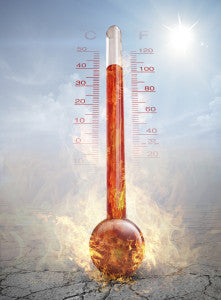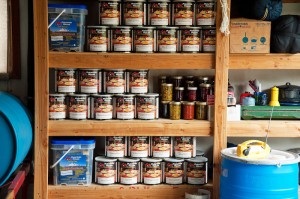Author Carol Lynn Pearson once imagined a disastrous food storage location in her book, “The Model Mormon Mother’s Notebook.”
“Crib mattress sprouting!” she wrote. “Replace other places to store wheat.”
Actually, below a crib might not be the worst place to put long-term food storage, if it’s done right. Now that the summer heat is here, it’s time to consider if your long-term food storage is in a safe location.
The U.S. Department of Agriculture recommends storing nonperishable food in a cool, dry place away from sunlight.
“Never put [canned goods] above or beside the stove, under the sink, in a damp garage or basement, or any place exposed to high or low temperature extremes,”
the USDA advised.

It’s especially important to store food correctly during the summer for several reasons. First, high temperature can cause food to break down faster.
A general rule of thumb for chemical reactions is that reactions double their rate for each temperature increase of 10 degrees Celsius. There’s too much variability for that rule of thumb to apply constantly. But, heat will cause food in storage to break down faster. This breakdown changes food’s appearance and flavor, and can cause nutrient loss.
In addition, many types of canned foods contain bacteria called thermophiles, which prefer high temperatures,
according to the U.S. Food and Drug Administration. They don’t grow under normal storage conditions, but do and can cause spoiling at high temperatures (50-55°C). That’s 122-131°F, but the USDA says temperatures above 100°F can damage canned goods. The USDA recommends keeping food at temperatures below 85 °F, and most experts prefer below 70 °F.
“The risk of spoilage jumps sharply as storage temperatures rise. In fact, canned goods designed for use in the tropics are specially manufactured,”
according to a USDA fact sheet.
Exposure to sunlight can cause rapid temperature changes, as anyone knows who’s touched a metal slide during the summer. These rapid transitions are also bad for food storage. Also, light can cause nutrient loss and a change in appearance for food in glass containers,
according to Jan Rasmussen from the University of Minnesota extension service.
Frozen cans can have more
acute problems. As liquid inside a can freezes, it expands. That can cause the can to bulge, creating microscopic holes large enough for bacteria to enter. Cans are unsafe if they are frozen, thawed, and refrozen, according to the USDA. Frozen cans can, however, safely be defrosted in the refrigerator.
“If the canned food is still frozen, let the intact can thaw in the refrigerator before opening. If the product doesn't look and/or smell normal, throw it out. Do not taste it,” the USDA fact sheet advised.

Also important: keep food storage
off the floor. First, it reduces the likelihood of pests getting into the home and food. Second, cement floors can be damp. Cans and metal lids on glass jars are usually made of steel and can rust on a damp surface. Rust puts tiny holes in cans, which
can allow bacteria to enter. Discard heavily rusted cans or those with rust inside. Rust that a paper towel can wipe away is not serious, according to the USDA.
With canned goods, watch for these
warning signs: loose or bulging lids on jars, dented, swollen or leaking cans, or food that smells bad or looks cloudy when it shouldn’t.
“If the cans look ok, they are safe to use,” the USDA fact sheet said.
According to the
USDA fact sheet, canned foods are safe indefinitely if not exposed to temperatures below freezing or above 90 °F. High-acid canned food like tomatoes and some fruit will keep their best quality for 12 to 18 months; low-acid canned food like meat and vegetables will for 2 to 5 years.
Keep food storage in a climate-controlled area away from windows and moisture (we recommend storing your food at temperatures less than 70 °F). Put dry goods in plastic or glass containers or cans to keep rodents and bugs out. Put newer food storage items behind older ones.
And maybe avoid crib mattresses.

 It’s especially important to store food correctly during the summer for several reasons. First, high temperature can cause food to break down faster. A general rule of thumb for chemical reactions is that reactions double their rate for each temperature increase of 10 degrees Celsius. There’s too much variability for that rule of thumb to apply constantly. But, heat will cause food in storage to break down faster. This breakdown changes food’s appearance and flavor, and can cause nutrient loss.
In addition, many types of canned foods contain bacteria called thermophiles, which prefer high temperatures, according to the U.S. Food and Drug Administration. They don’t grow under normal storage conditions, but do and can cause spoiling at high temperatures (50-55°C). That’s 122-131°F, but the USDA says temperatures above 100°F can damage canned goods. The USDA recommends keeping food at temperatures below 85 °F, and most experts prefer below 70 °F.
“The risk of spoilage jumps sharply as storage temperatures rise. In fact, canned goods designed for use in the tropics are specially manufactured,” according to a USDA fact sheet.
Exposure to sunlight can cause rapid temperature changes, as anyone knows who’s touched a metal slide during the summer. These rapid transitions are also bad for food storage. Also, light can cause nutrient loss and a change in appearance for food in glass containers, according to Jan Rasmussen from the University of Minnesota extension service.
Frozen cans can have more acute problems. As liquid inside a can freezes, it expands. That can cause the can to bulge, creating microscopic holes large enough for bacteria to enter. Cans are unsafe if they are frozen, thawed, and refrozen, according to the USDA. Frozen cans can, however, safely be defrosted in the refrigerator.
“If the canned food is still frozen, let the intact can thaw in the refrigerator before opening. If the product doesn't look and/or smell normal, throw it out. Do not taste it,” the USDA fact sheet advised.
It’s especially important to store food correctly during the summer for several reasons. First, high temperature can cause food to break down faster. A general rule of thumb for chemical reactions is that reactions double their rate for each temperature increase of 10 degrees Celsius. There’s too much variability for that rule of thumb to apply constantly. But, heat will cause food in storage to break down faster. This breakdown changes food’s appearance and flavor, and can cause nutrient loss.
In addition, many types of canned foods contain bacteria called thermophiles, which prefer high temperatures, according to the U.S. Food and Drug Administration. They don’t grow under normal storage conditions, but do and can cause spoiling at high temperatures (50-55°C). That’s 122-131°F, but the USDA says temperatures above 100°F can damage canned goods. The USDA recommends keeping food at temperatures below 85 °F, and most experts prefer below 70 °F.
“The risk of spoilage jumps sharply as storage temperatures rise. In fact, canned goods designed for use in the tropics are specially manufactured,” according to a USDA fact sheet.
Exposure to sunlight can cause rapid temperature changes, as anyone knows who’s touched a metal slide during the summer. These rapid transitions are also bad for food storage. Also, light can cause nutrient loss and a change in appearance for food in glass containers, according to Jan Rasmussen from the University of Minnesota extension service.
Frozen cans can have more acute problems. As liquid inside a can freezes, it expands. That can cause the can to bulge, creating microscopic holes large enough for bacteria to enter. Cans are unsafe if they are frozen, thawed, and refrozen, according to the USDA. Frozen cans can, however, safely be defrosted in the refrigerator.
“If the canned food is still frozen, let the intact can thaw in the refrigerator before opening. If the product doesn't look and/or smell normal, throw it out. Do not taste it,” the USDA fact sheet advised.
 Also important: keep food storage off the floor. First, it reduces the likelihood of pests getting into the home and food. Second, cement floors can be damp. Cans and metal lids on glass jars are usually made of steel and can rust on a damp surface. Rust puts tiny holes in cans, which can allow bacteria to enter. Discard heavily rusted cans or those with rust inside. Rust that a paper towel can wipe away is not serious, according to the USDA.
With canned goods, watch for these warning signs: loose or bulging lids on jars, dented, swollen or leaking cans, or food that smells bad or looks cloudy when it shouldn’t.
“If the cans look ok, they are safe to use,” the USDA fact sheet said.
According to the USDA fact sheet, canned foods are safe indefinitely if not exposed to temperatures below freezing or above 90 °F. High-acid canned food like tomatoes and some fruit will keep their best quality for 12 to 18 months; low-acid canned food like meat and vegetables will for 2 to 5 years.
Keep food storage in a climate-controlled area away from windows and moisture (we recommend storing your food at temperatures less than 70 °F). Put dry goods in plastic or glass containers or cans to keep rodents and bugs out. Put newer food storage items behind older ones.
And maybe avoid crib mattresses.
Also important: keep food storage off the floor. First, it reduces the likelihood of pests getting into the home and food. Second, cement floors can be damp. Cans and metal lids on glass jars are usually made of steel and can rust on a damp surface. Rust puts tiny holes in cans, which can allow bacteria to enter. Discard heavily rusted cans or those with rust inside. Rust that a paper towel can wipe away is not serious, according to the USDA.
With canned goods, watch for these warning signs: loose or bulging lids on jars, dented, swollen or leaking cans, or food that smells bad or looks cloudy when it shouldn’t.
“If the cans look ok, they are safe to use,” the USDA fact sheet said.
According to the USDA fact sheet, canned foods are safe indefinitely if not exposed to temperatures below freezing or above 90 °F. High-acid canned food like tomatoes and some fruit will keep their best quality for 12 to 18 months; low-acid canned food like meat and vegetables will for 2 to 5 years.
Keep food storage in a climate-controlled area away from windows and moisture (we recommend storing your food at temperatures less than 70 °F). Put dry goods in plastic or glass containers or cans to keep rodents and bugs out. Put newer food storage items behind older ones.
And maybe avoid crib mattresses.



3 comments
Yolanda
When utilizing the Maylar Bags with the Oxigen Absorbers in a tropical climate what will help keep foods cool when the electricity temporarily goes out for a few hour or days? Any ideas?
JJ
Mark – avoid canned good altogether unless it’s canned dry goods like powdered milk or freeze dried veggies/meat. Otherwise, there are lots of great foods that are easily bagged up: oatmeal/oatmeal individual serving packets, nutrition bars (w/o chocolate), raisins/cranraisins, nuts of all kinds. You get the idea.
Mark Theodoroff
Our mailman wants us to fill a plastic bag with non-perishable items for a food drive. We are to put them on top of the metal mail box (which means food is sitting in the direct sunlight). How long, on a hot sunny day (temps around 80 to 90) can these canned foods like corn, green beans or chili sit there without spoiling? They do this every year, and I never put out any food because I figure it would spoil. Duration in direct sun = 1 to 4 hours, depending on when mailman shows up.
What are the best foods to put out there that will not be adversely affected by the sun and heat?
Thanks, Mark